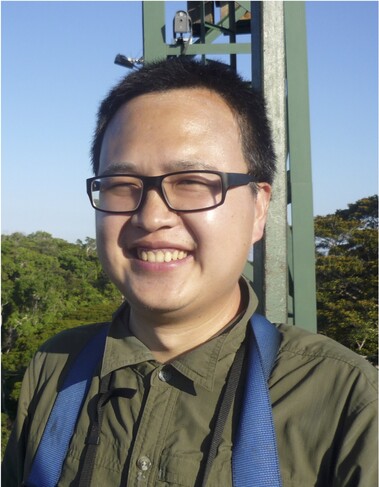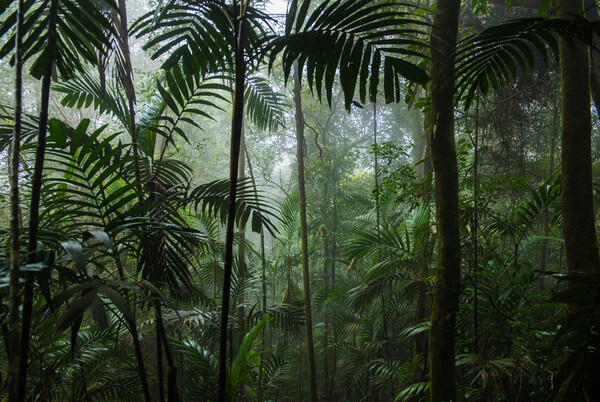 | Dr Jin WU Assistant Professor of School of Biological Sciences
Global Ecology and Remote Sensing Lab
|
1. What do you think are your most significant research accomplishments, and what has been the impact of your research?
My research covers a wide range of topics in global ecology and remote sensing, including developing novel space technology for plant ecology, exploring mechanisms of plant-climate interactions, improving math representations of these mechanisms in computer models, and leveraging cutting-edge sensor technologies and models to advance both real-time Earth’s surface monitoring and longer-term projection of climate change impacts. I have published 62 papers with over 2700 citations and have an H-index of 27. These include first or corresponding authored papers in top journals including Science, Global Change Biology, New Phytologist, and Remote Sensing of Environment, as well as co-authored papers in Nature, PNAS, Nature Geoscience, Nature Plants, and Nature Ecology & Evolution. I was awarded with NSFC-Excellent Young Scholar in 2019, Best Young Investigator Paper Award of the Sino-Ecologists Associations in 2018, and Goldhaber Distinguished Fellowship from Brookhaven National Laboratory in 2017.
My research explores how forest ecosystems respond to climate change from mechanistic and methodological perspectives. From a mechanistic perspective, by integrating leaf and canopy-scale ecophysiology with eddy covariance measurements of ecosystem functioning, my research demonstrated the time-scale dependent mechanisms of climatic and biotic controls in regulating forest ecosystem functioning from hours to decadal timescales (Wu et al., Global Change Biology, 2017a). In addition to the climatic control, I for-the-first-time proposed that there are two aspects of leaf phenology (quantity and quality), and demonstrated that the phenology of leaf quality, rather than the commonly understood leaf quantity phenology, dominantly regulates forest ecosystem functioning, as the newly flushing leaves have much higher quality (physiological capacity) than the old leaves being replaced, and thus leaf quality importantly determines forest ecosystem functioning (Wu et al., Science, 2016; Wu et al., Global Change Biology, 2017b, 2020). These findings advance the mechanisms of forest ecosystem response to climate variability, and offers improved math representations of these mechanisms in computer models that we rely on to predict future terrestrial ecosystem functioning.
From a methodological perspective, my group has been developing novel sensor techniques to help characterise both aspects of plant phenology, ranging from proximate (Wu et al., New Phytologist, 2017, 2019; Song et al., ISPRS of Photogrammetry and Remote Sensing, 2021) to satellite (Wang et al., Remote Sensing of Environment, 2020, 2021; Wu et al., ISPRS of Photogrammetry and Remote Sensing, 2021) remote sensing. Additionally, I developed a novel model-data integration approach that transparently scales up the fine-scale mechanisms to the ecosystem-scale that can be sensed by satellites (Wu et al., New Phytologist, 2018), which ultimately leads to the resolution of a recent high profile debate between Morton et al (2014) Nature and Saleska, Wu, et al (2016) Nature. Finally, by integrating these multi-scale observations with state-of-the-art models, my lab research improves biophysical interpretation of satellite observations, offering rich satellite-derived biophysical variables across both space and time to assess the climate change impacts on terrestrial ecosystem functioning.
Collectively, my research is inspired by fundamental research questions in ecology but critically, the research outputs also help to resolve several pressing environmental issues related to climate change (forest health monitoring and management, precision agriculture, climate change impacts and mitigation).
Throughout these research, I hope to generate important outcomes that ultimately can lead to actionable plans to help sustain our natural ecosystems with global climate change.

2. A brief description of 1 - 2 ongoing research projects that best reflect your visions in the scientific field.
Here I would like to share two types of ongoing research projects that my lab has been working on.
The first type (on the Fundamental Science side) aims to explore the eco-evolutionary mechanisms that regulate leaf phenology variability from tree individuals up to forest ecosystem levels, with the funding support from the Research Grants Council’s Early Career Scheme and General Research Fund grants. Leaf phenology is important not only because it shows high sensitivity response to global climate change, but also because it importantly mediates large-scale biogeochemical cycles of carbon and water that would either deaccelerate or accelerate the global climate change speed. Although much attention has been focused on the ecosystem-scale phenology-climate relationships (that can be sensed by traditional satellite techniques), whether plant biodiversity also plays a role in regulating phenology-climate relationships and thus determines forest ecosystems as a whole responding to climate change remains unknown, primarily because of the lack of fine-scale observations. To address this knowledge gap, we will first develop novel remote sensing methods (that leverage the new generation of satellite observations (CubeSats) with a 3-m spatial resolution) to improve fine-scale phenology monitoring, and then integrate these with field observations of plant functional traits across environmental gradients to explore the underlying mechanisms that drive fine-scale phenology variability and determine the higher-level sensitivity response to climate change. We expect that the outcomes of these research works would not only improve the phenology mechanism across a wide range of scales (from tree individuals to forest ecosystems), but also provide important datasets and math representations to improve process models of terrestrial ecosystem responses, by which we can gain more confidence in assessing the climate change impacts on our natural ecosystems.
The second type (on Applied Science side) aims to use Hong Kong as an example to explore the potential best pathway that we can take to reach carbon neutrality with considering co-benefits of net carbon sequestration and biodiversity service from natural and managed forest ecosystems. The project is funded by Hong Kong Bank Foundation, with Dr Billy HAU from HKU as the Principal Investigator, and me as one of the two Co-Investigators of this project. Increasing consensus has suggested human-induced carbon emissions as the major cause of recent global warming, and if we keep business as usual, our planet will turn into a much warmer and less habitable planet with various climate change-induced disasters that will ultimately affect the lives or living quality of billions of people across the world. To solve the climate change problem (one of the major threats to us human being in the 21st century), the carbon neutrality action plan has been increasingly advocated at the state/national level, including Hong Kong and Mainland China. To reach the carbon neutrality goal (carbon uptake = carbon emission), the carbon uptake by plants is one of the most important approaches to balance out the carbon emission by human society. However, most prior attention remains focused solely on the carbon uptake potential from afforestation, with less attention on the potential associated ecological problems (e.g. vulnerability of restored forest ecosystems to climate extremes) and benefits (e.g. maintenance of biodiversity and other ecosystem services). Hong Kong is ideal for this exploration, as after the Second World War, various afforestation strategies have been taken to restore the Hong Kong forests with divergent consequences in terms of net carbon sequestration, ecological services and biodiversity maintenance. Thus, in this project, we aim to leverage historical and ongoing data of biometry surveys, aerial photos, together with the repeated airborne-based LiDAR surveys, and satellite measurements, to fully explore the potential best afforestation strategy that can maximize the co-benefits of net carbon sequestration and biodiversity maintenance. Upon the successful exploration in Hong Kong through this project, the developed methodology and proposed theoretical framework can further be extended to other regions, by which we hope to offer important nature-based solutions to best mitigate the climate change impacts.
3. What is the most important question you want to address?
The most important question that my lab has been addressing is how forest ecosystems would respond to global climate change, and how the change in forest ecosystem structure, composition, and function will further generate feedbacks to either buffer or facilitate the climate change.
4. Can you give an example of your translational work?
The revealed fundamental mechanism that explains the phenology-photosynthesis relationship of tropical forest ecosystems in Wu et al (2016) Science has been highly recognised in the field, which now has been turned into a set of new rules (or math representations) and implemented in a state-of-the-art terrestrial biosphere model (ORCHIDEE; Chen et al., 2020), with demonstrated model performance improvements in simulating tropical forest physiological responses to climate variability and change.
5. Where do you see yourself in five years/ten years? What do you want to accomplish the most?
I first define myself as a scientist working on fundamental research. With this, I expect that my lab and I would discover a set of rules that improve the mechanistic understanding of how forest ecosystems respond to global climate change (in terms of plant ecophysiology, phenology, species composition, and ecosystem services), enriching the theories of plant ecophysiology and eco-evolution.
I also define myself as a practical scientist who is equipped with cutting-edge geospatial techniques and modeling skills, by which I expect that my lab and I can translate the advances in science and technology to help resolve several pressing environmental issues that we are facing today. The example applied science problems that we have been working on/will work on include, but are not limited to, smart forestry (that integrates health monitoring, management and conservation practices), smart agriculture (that leverages science and technology to alleviate food security problems), and climate change impact assessments and mitigation plans.
Last, I define myself a mentor and educator, by which I hope to raise my students’ awareness on contemporary climate change problems, and equip them with necessary knowledge and skillsets to help mitigate climate change problems.
6. How would you bridge the gap from your research to research users
This is a very good question. In the longer term, I am thinking to collaborate with stakeholders and industry partners, by which we can immediately translate our research into something useful that can make direct impacts to end users and help resolve some real-world environmental and ecological problems.
7. What are the challenges you are facing?
From the scientific research perspective, two immediate challenges that we are facing now include: 1) since our research needs to deal with big remote sensing data, so the necessary support from the IT department (regarding the big data storage and processing platform) and collaborations with AI experts are greatly needed, and diverse platforms that facilitate our communications and collaborations with world-leading experts in this field (including inviting them to visit HKU or initiating conferences/workshops to gather world-experts to meet in HK) can be very helpful to present/promote our research to even larger science communities, and inspire even more important scientific explorations and collaborations.
From the connection with industry partners/stakeholders perspective, we need more opportunities to interact with them, by which we can understand better regarding how to translate our research work into something useful in the real-world. Meanwhile, it also serves as a mirror to ask ourselves whether the proposed research is truly important, and how we can tail the research to make even more far-reaching impacts.
8. Who has influenced you the most?
My PhD supervisor Professor Scott SALESKA, who brought me to the ecology field, shared his great passion in scientific research, and instructed me to become a good and solid scientist, and a good educator and communicator as well.
9. How would you go about motivating yourself when you are going through a low point?
Slow down, relax, and think deeply. I will also turn to some friends, and hear the voices from diverse perspectives.
10. Can you tell us more about your research group? What are the roles and the missions?
Our research group, or Global Ecology and Remote Sensing Laboratory, is composited by a mixture of students, research assistants and postdocs. The team has diverse expertise in GIS, remote sensing, modeling and ecology, but shares similar research missions that aim to bring domain knowledge, satellite data, supercomputing and machine learning together to advance the fundamental ecological science or to help resolve critical real-world environmental problems.

